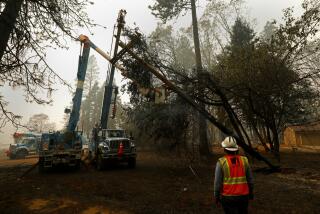Utility Claims Bankruptcy as Seabrook Delays Mount
- Share via
Financially troubled Public Service Co. of New Hampshire, which owns nearly 36% of the stalled Seabrook nuclear power plant, filed for bankruptcy Thursday--the nation’s first major investor-owned utility to seek court protection since the Great Depression.
With almost $3 billion in assets, it is also the fourth-largest U.S. company to file under Chapter 11 of the federal bankruptcy code. Under Chapter 11, a company is allowed to continue operation while seeking to devise a reorganization plan, under court supervision, that is satisfactory to a majority of its creditors.
The utility, New Hampshire’s largest, furnishes electricity to about three-quarters of the state’s 1,027,000 residents.
Public Service sought protection through the federal court in Manchester from the claims of three banks representing creditors seeking control of its $2.7 billion in assets. These include $2.1 billion invested in the $5.4-billion Seabrook facility, which was completed in mid-1986. Eleven other New England utilities own the remaining 64% share.
At a news conference, utility President Robert Harrison said the company took the action because there was “a very high probability” that creditors would seek to force the utility into involuntary bankruptcy as early as today.
Harrison said Public Service will seek to continue paying its share of the cost of carrying Seabrook, and he pledged to forge ahead with efforts to license the plant. “I do not see this action as any problem in that regard,” he said.
Seabrook already is licensed by the federal Nuclear Regulatory Commission to load fuel, which has been done, and to perform non-nuclear testing. But the plant’s start-up has been delayed by the refusal of environmentalists, anti-nuclear advocates and officials in neighboring Massachusetts, led by Democratic Gov. Michael S. Dukakis, to participate in emergency evacuation planning.
A number of Massachusetts communities are within 10 miles of the plant, which itself is 40 miles from Boston. Under federal law, these communities must participate in evacuation planning.
Dukakis, a Democratic presidential candidate, has fiercely opposed Seabrook, as have many of New Hampshire’s Democrats. But Seabrook also has become a rallying point for the anti-nuclear movement and environmentalists generally, who have strenuously objected to its opening.
Manchester lawyer Robert Backus, a longtime Seabrook foe, called the filing “recognition that the Seabrook plant is--and was--an economic disaster, . . . a mistake.”
New Hampshire Gov. John H. Sununu, a Republican and one of Seabrook’s staunchest supporters, called the bankruptcy filing “unfortunate.”
Sununu said that the company has “a host of alternatives . . . to protect both the ratepayers of New Hampshire and the state’s energy supply.”
Rate Increase Denied
The bankruptcy move came just two days after the New Hampshire Supreme Court denied a 15% emergency rate increase. The Manchester-based company had sought the increase since August to help it meet debt obligations stemming from Seabrook’s construction. The state court said a utility cannot charge its customers for the cost of a plant that has yet to provide them power.
Industry analysts had predicted the bankruptcy filing. Paul Parshley of Donaldson, Lufkin & Jenrette, for example, reported on Jan. 11 that statements by members of Seabrook’s joint ownership committee made it evident that “they will have to go through some sort of court action, probably under a Chapter 11 proceeding.”
The most certain immediate losers are the company’s shareholders, Tom Hamlin of Chicago-based Duff & Phelps said in an interview. Seabrook, he said, has become “a big, expensive political football.”
The company’s common stock closed unchanged at $2.625 a share in composite trading on the New York Stock Exchange.
Public Service has struggled for months to avoid bankruptcy. In October, it missed a scheduled payment on $800 million of its bonds. Much earlier, in April, 1984, its directors suspended dividend payments, and the company now owes holders of its preferred stock more than $138.3 million in accumulated dividend payments.
Halts Plant Construction
Public Service skirted bankruptcy then, and halted construction on the giant plant for about three months until the state Supreme Court let it borrow $425 million. The utility continued borrowing heavily to finish the reactor and maintain interest payments until investors last summer refused to make further loans.
Since then, Public Service tried what it called an out-of-court bankruptcy reorganization that included budget cuts, an attempt to restructure its debt and the aborted request for a 15% rate increase.
“It’s unfortunate this had to happen,” analyst Hamlin said, “because the plan the company was formulating looked like it could solve everybody’s problem. But the (state) Supreme Court ruling killed them. Now everything’s up in the air.”
Dukakis has refused to submit evacuation plans for the six coastal communities in his state that fall within the emergency planning zone, maintaining that no such plan could work.
Seabrook submitted its own plans for Massachusetts, and the Nuclear Regulatory Commission last fall approved a rule change that could allow them to be approved, but Seabrook foes have appealed the change in federal court.
In New Hampshire, Sununu submitted--and the NRC staff approved--evacuation plans for the 17 communities falling into the evacuation zone within his state. But the Federal Emergency Management Agency rejected the plans, saying they would not protect summer crowds on nearby beaches.
More to Read
Sign up for Essential California
The most important California stories and recommendations in your inbox every morning.
You may occasionally receive promotional content from the Los Angeles Times.













